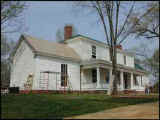
From the Caswell Messenger newspaper:
Milton's Foote plantation
In the southwest corner of Halifax County, close to Milton, North Carolina,
stands a home with connections to the wealthy Bruce family. Scholars come to
Southside Virginia from across the nation to study the Bruce homes at Berry Hill
and Staunton Hill. Local historians have worked through the records of Tarover
and Morotock. South Bend goes unnoticed and may soon disappear. While the home.
has been vacant for many years and has suffered some damage, the solid timbers
of the framing are still strong.
During the Bruce years, South Bend was remodeled into a fashionable home. The
frame house was built in three stages. The earliest part was a story and a half
house with three rooms in a line. Later owners heard that this section was moved
to its present site from an earlier location. The front section which rises to a
full two stories was the second stage. A center hall with matching rooms on each
side was its basic plan.
This second stage was probably the work of Fielding B. Lewis for the woodwork
is typical of the 1840s and 1850s. The last work was additions placed at each
end of the second house. The front four rooms of the enlarged house had new
molding and trim installed around doors and windows making old and new rooms
match. Written in pencil on plaster within the alcoves in the parlor are "W.T.
Farley Contractor, Milton, N.C. July 21, 1876" and "Built By W.T.
Farley, Milton, July 21, 1876." The date reasonably fits the third phase of
construction. A servants' wing runs off the back porch and is connected by a
covered porch to the main house. This wing is typical of Bruce family dwellings.
South Bend was not as isolated during the Bruce years as it appears today.
The Milton and Sutherlin Narrow Gauge Rail Road Company built a line after 1877
to connect Milton to the Richmond and Danville line. The track right-ofway
passed a short distance from South Bend. When a later railroad came through
Milton from Clarksville to Danville, the narrow gauge was torn up and its right-ofway
became a public road.
Not long after her husband's death, Kate Bruce placed South Bend up for
public auction. E.B. Foote was traveling through South Boston and saw
announcements for the sale. He remained in town to await the event. He purchased
the home and its contents, along with 1156 acres, for $17,500. The deed was
recorded in 1907. Ellsworth Baldwin Foote was a native of Ohio and resided in
Centralia, Washington, with his wife, Clara Van Norman, and their four sons.
When the family relocated to Virginia, Fred was fifteen, the twins, John and
Jay, were eleven, and William was seven. Fred died at South Bend in the summer
after his first year at V.P.I. The cemetery contains this single grave.
E.B. Foote turned South Bend into a prosperous farm and was actively involved
in increasing its productivity. Much of the land was cleared and a dairy herd
was established. Power to operate the milking machinery came from an electrical
system installed by E.B. Foote. A mill, powered by electricity, with ample
storage bins for grains produced feed for the herd. He experimented with
concrete construction and several foundations and walls have survived. Through
the efforts of Mr. Foote and his sons, the farm reached a high state of
cultivation
E.B. Foote and his wife, Clara, turned the farm over to their twin sons, John
and Jay, when they sought the warmer climate of Florida. Florida became their
last home and both were buried in Delray Beach, an ocean-front resort between
Fort Lauderdale and West Palm Beach. William Foote, the youngest son was settled
in Colorado with no interest in farming. John and Jay were running South Bend's
farming operation and they became the new owners.
When the Footes moved away from South Bend to the bright lights of Milton,
South Bend entered a period of decline. Fancy Victorian wallpaper now hangs from
the walls in shreds, missing window panes permit cold breezes to whistle through
the still rooms, and trees grow from the foundation of South Bend.
The home has been vandalized and mantels have disappeared. If South Bend is
allowed to disappear, at least some visual record has been made to preserve its
memory.
-by Gerald Gilliam